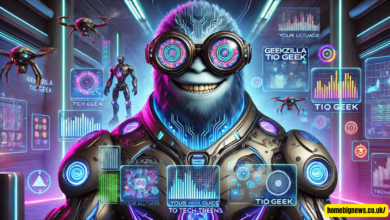The Comprehensive Guide to the [xcv panel]: Everything You Need to Know
![The Comprehensive Guide to the [xcv panel]: Everything You Need to Know xcv panel](https://homebignews.co.uk/wp-content/uploads/2024/11/xcv-panel-780x470.webp)
In today’s rapidly evolving world of technology, there are countless innovations that play a crucial role in shaping industries and everyday life. One such innovation that has been gaining traction is the [xcv panel]. But what exactly is it, and how does it benefit various sectors? Whether you’re a curious tech enthusiast or someone seeking to incorporate the [xcv panel] into your workflow, this article will provide you with all the essential details to fully understand its features, applications, and future potential.
What is the [xcv panel]?
The [It] is a versatile and advanced technological tool, commonly used in a wide range of industries. It functions as a key component in various systems, including electronics, engineering, and even some specialized fields such as data analysis or control automation. While it may seem technical, the core concept of the [xcv panel] is rather simple: it serves as a central hub for interaction with complex systems, often featuring a touch-sensitive interface that allows users to control or monitor various functions.
In essence, the [It] is designed to make interacting with intricate systems much more intuitive and accessible. Its advanced features and user-friendly design make it indispensable in modern technology setups.
Key Features of the [xcv panel]
What makes the [It] stand out from other similar devices? Let’s take a look at some of its key features that have earned it a place in the spotlight:
- Touchscreen Interface: One of the defining features of the [It] is its responsive touchscreen. This allows users to control the device with ease, without the need for physical buttons or dials.
- Customizability: The [It] can be customized to suit specific needs, with different layouts and options available to tailor it to the user’s requirements.
- Multifunctional: Whether you need it for data monitoring, machine control, or system diagnostics, the [It] is a multifunctional tool that serves various roles within industrial or commercial settings.
- Durability: Built to withstand harsh environments, the [t] is designed to endure high temperatures, moisture, and dust, making it ideal for use in factories, warehouses, and outdoor operations.
- Connectivity: The [It] supports various communication protocols, allowing it to seamlessly integrate with other devices and systems, such as PLCs (Programmable Logic Controllers) or SCADA (Supervisory Control and Data Acquisition) systems.
- Energy Efficiency: Many versions of the [It] are engineered with energy-saving features, making them eco-friendly and cost-effective in the long run.
How Does the [xcv panel] Work?
Understanding the operation of the [It] requires diving into its technology. Here’s a basic breakdown of how it works:
- User Input: The first step is user input, which typically comes via a touchscreen interface. The user taps or swipes to input commands or select options on the screen.
- Processing: Once the input is received, the [It] processes the data using an embedded microprocessor or microcontroller. This is where the logic of the system comes into play.
- Action: After processing the input, the [It] sends commands to the connected devices or systems to perform the desired action. This could be anything from adjusting settings to triggering alarms.
- Feedback: The [It] may also provide feedback to the user, such as displaying updated status information or notifications based on the results of the action.
Applications of the [xcv panel] in Different Industries
The [xcv panel] has a wide array of applications across various industries. Its ability to simplify and streamline complex operations makes it a valuable tool in many settings. Let’s take a closer look at some of its key applications:
- Manufacturing: In factories, the [xcv panel] is used to control machines, monitor production lines, and even adjust parameters based on real-time data. This makes it easier for workers to optimize operations and respond to issues quickly.
- Automation: The [It] plays a critical role in industrial automation, where it connects with systems like PLCs and SCADA to automate processes and ensure smooth functioning.
- Energy Management: For energy-intensive industries like oil and gas, the [xcv panel] helps monitor and control energy usage, ensuring maximum efficiency and reducing waste.
- Healthcare: In the medical field, the [It] is used in equipment like diagnostic machines, providing doctors with real-time data and control over complex devices.
- Transportation: The [It] can be used in vehicles, such as buses, trains, or even airplanes, to monitor and control various systems, such as navigation, communication, or engine performance.
- Smart Homes: As part of the growing trend of smart homes, the [It] can serve as a central hub for controlling lighting, heating, security systems, and other home automation devices.
Benefits of Using the [xcv panel]
Why should industries and individuals invest in the [xcv panel]? Here are some key benefits to consider:
1. Increased Efficiency
The [xcv panel] allows for quicker decision-making and more efficient control of systems, minimizing downtime and enhancing overall productivity.
2. Improved User Experience
Thanks to its touchscreen interface and customizability, users can interact with systems in a way that is intuitive and easy to understand, even for those with minimal technical expertise.
3. Enhanced Flexibility
The [xcv panel]’s adaptability makes it suitable for a wide range of applications. Whether you’re managing a large-scale industrial system or monitoring a small home automation setup, the [xcv panel] can be tailored to fit your needs.
4. Cost Savings
With its energy efficiency and reliability, the [xcv panel] can help companies reduce operational costs in the long run by preventing system failures and minimizing the need for costly maintenance.
5. Scalability
As systems grow and evolve, the [xcv panel] can scale to meet the increased demands. This makes it an excellent choice for both small and large projects, ensuring that your setup remains future-proof.
The Future of the [xcv panel]
The [xcv panel] is undoubtedly a technological marvel that continues to evolve. With the rapid advancements in the Internet of Things (IoT) and AI, the future of the [xcv panel] looks even brighter. Here are some potential developments to look out for:
- Smarter Interfaces: As AI and machine learning continue to improve, the [xcv panel] could become even more intuitive, anticipating user needs and providing predictive analytics.
- Enhanced Connectivity: The rise of 5G and improved wireless communication could make the [xcv panel] even more connected, allowing for real-time monitoring and control from virtually anywhere.
- Integration with Virtual Reality (VR): In more complex industries, VR integration could allow users to interact with the [xcv panel] in immersive 3D environments, offering a more hands-on approach to system management.
- Sustainability: As industries continue to focus on sustainability, the [xcv panel] may incorporate more eco-friendly materials and energy-saving technologies.
Choosing the Right [xcv panel] for Your Needs
When selecting the ideal [xcv panel] for your purposes, there are several factors to consider:
- Screen Size: Depending on the complexity of the system, you may need a larger screen for more detailed data or a smaller one for simple control functions.
- Connectivity Options: Ensure that the [xcv panel] supports the necessary communication protocols for your system, such as Ethernet, Wi-Fi, or Bluetooth.
- Durability: If you’re working in harsh environments, opt for a model with enhanced durability, such as an IP-rated panel that can withstand dust, moisture, and extreme temperatures.
- User Interface Design: Look for a panel with an intuitive design that matches your team’s skill level. Some models offer customizable interfaces, while others come pre-configured for specific applications.
Common Challenges with the [xcv panel]
While the [xcv panel] offers many benefits, there are also some challenges that users may encounter:
- Cost: High-end models can be costly, particularly for small businesses or startups. However, the return on investment (ROI) is often worth it in the long run.
- Learning Curve: For users unfamiliar with advanced tech, there may be a learning curve. Training is essential to ensure maximum efficiency.
- Integration Issues: Depending on the systems you’re working with, integrating the [xcv panel] may require additional software or hardware components, which could complicate the setup process.
Conclusion: The [xcv panel] – A Game Changer in Technology
In conclusion, the [xcv panel] represents a significant advancement in the world of technology, offering a host of benefits that can revolutionize the way businesses and individuals interact with complex systems. Whether you’re in manufacturing, healthcare, or any other sector, the [xcv panel] is designed to improve efficiency, flexibility, and control.
By understanding its features, applications, and potential, you’ll be better equipped to make an informed decision about whether the [xcv panel] is the right choice for your needs. As technology continues to advance, the [xcv panel] will undoubtedly play an even more significant role in shaping the future of automation, user interaction, and system management. Don’t hesitate to explore the possibilities and take full advantage of this cutting-edge tool!





